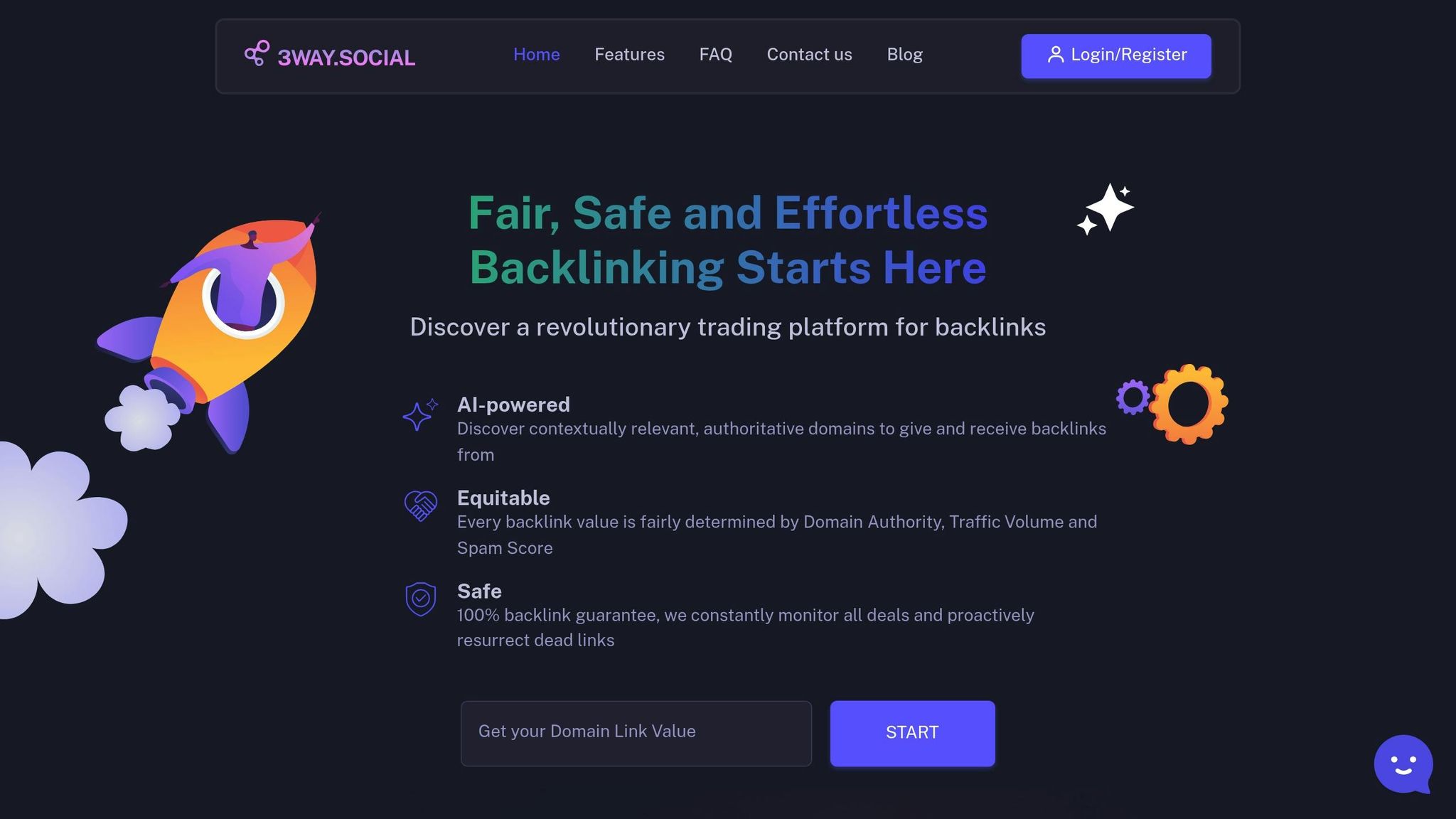Last Updated on June 30, 2025 by Becky Halls
Want to improve your website’s SEO? Start by analyzing your competitors’ backlinks. Here’s how tracking their backlink strategies can help you:
- Understand what works: See which content and domains earn your competitors the most backlinks.
- Spot opportunities: Identify high-authority websites linking to competitors but not to you.
- Fill gaps: Discover areas where your strategy can improve by analyzing trends and link-building speed.
- Use tools: Platforms like Ahrefs, Semrush, and Moz can simplify the process.
- Act on insights: Replicate successful strategies, reach out for broken links, and diversify your backlink sources.
Key takeaway: Backlinks are crucial for SEO. The top-ranking page on Google often has 3.8x more backlinks than the rest of the top 10 combined. Use competitor insights to refine your strategy and boost rankings.
Backlink Competitor Analysis – How To Build Quality Backlinks
Step 1: Identify Your Competitors
To start, pinpoint the websites that show up when your potential customers search for your target keywords. These are your SEO competitors, and they might not always align with your traditional business rivals. Essentially, these are the sites grabbing the attention of the audience you want to reach.
Define Your Niche and Keywords
Begin by listing the core keywords and topics your customers are likely searching for when looking for your products or services. These keywords will act as your guide in identifying the right competitors to monitor.
Aim for a list of 10–15 primary keywords that reflect your main offerings. Include a mix of broad terms (like “project management software”) and long-tail phrases (such as “team collaboration tools for remote workers”). Also, think about the intent behind each search – are users looking to buy, research, or compare options?
Use SEO Tools for Competitor Research
SEO tools can quickly show you which websites dominate your target keywords. These are the ones you’ll want to keep an eye on.
Platforms like Ahrefs and Semrush are particularly useful for this. Simply input your primary keywords, and these tools will generate a list of top-ranking domains. Ben Poulton, SEO consultant and founder of Intellar, highlights how effective these tools can be:
“Ahrefs is my go-to software for SEO, and their functionalities for competitor analyses are super helpful right out of the gate. I can create detailed reports on competitive benchmarking by keyword and category. These help me and clients quickly spot gaps, underperforming areas, or highly competitive terms we do well on, but want to make sure we maintain.”
Don’t stop there – use Google search to identify the top 10 ranking sites for each keyword. These are often your most direct competitors, as they’re capturing the visibility you’re aiming for.
For a more niche-focused approach, try searches like “[your industry] best blogs” or “top [your industry] directories.” These can uncover authoritative sites you might have overlooked. Additionally, tools that show websites linking to multiple competitors can highlight valuable outreach opportunities.
Refine Your Competitor List
Not every site ranking for your keywords is worth your attention. It’s important to narrow your list to competitors that directly impact your backlink strategy.
Start by prioritizing direct competitors – those offering similar products or services to your target audience. These are the sites most likely to provide actionable insights.
“Your direct competitors will be websites that rank high on page one (on Google or other search engines) for the same keywords you’re targeting. They offer similar products and services as you and are competing for the same target audience.”
Visit each competitor’s website to ensure their offerings and audience align with yours. A site might rank well but cater to a completely different market, making their backlink strategy less relevant to you.
Pay attention to the authority and quality of a competitor’s backlinks. Focus on sites with strong domain authority and a history of earning links from reputable sources. This ensures you’re learning from strategies that are both effective and relevant.
Keep your list manageable – 5 to 10 core competitors is usually enough. This allows you to dive deeper into their strategies without spreading yourself too thin.
Take inspiration from case studies like Happy Scribe’s 70,000 signups in November 2023 or Piktochart’s improved ranking for “presentation maker” (Source: skale.so, 2025). These examples show how refining your competitor list can uncover actionable backlink opportunities.
With your list in place, you’re ready to use advanced tools to track their backlink growth and strategies effectively.
Step 2: Select the Right Backlink Analysis Tools
Picking the right tools for tracking competitor backlink growth is a game-changer when it comes to effective analysis. The quality of your insights will depend on the features your chosen platform offers, so knowing what to look for can save both time and money.
Overview of Backlink Analysis Tools
There are several top-tier tools available for backlink analysis, each offering unique features. Here’s a breakdown of some popular options:
- Ahrefs: Known for its extensive backlink database and real-time updates. Plans start at $249/month for the Standard option and $449/month for the Advanced plan.
- Semrush: A comprehensive SEO platform that includes backlink analysis, keyword research, and competitive insights. Pricing begins at $249.95/month for the Guru package, with the Business plan at $499.95/month. It also features customizable dashboards for combining backlink data with other marketing metrics.
- Moz: Famous for its Domain Authority (DA) and Page Authority (PA) metrics. The Medium plan starts at $179/month, while the Large plan with advanced features is priced at $299/month. Moz uses its authority metrics to evaluate backlink quality.
- Majestic: Specializes in trust metrics for backlinks, making it ideal for those focused on link quality over quantity. The Pro plan starts at $99/month, and the Full API plan costs $399/month.
When choosing a tool, look for features like Link Intersect, which identifies domains linking to your competitors but not to you. This can help uncover valuable outreach opportunities.
While these tools are great for analysis, platforms like 3Way.Social simplify the actual process of acquiring backlinks.
Benefits of 3Way.Social for Link Building

3Way.Social uses AI to facilitate three-way link exchanges, creating natural-looking backlink profiles. Its AI-driven system matches partners based on metrics like Domain Authority, Traffic, and Spam Score.
Users have reported impressive results, including a 20% increase in traffic and a 30% boost in Domain Authority after exchanging over 10,000 links.
Alex Chen, a freelance SEO consultant, shared his experience:
“This platform has been a lifesaver for my link-building campaigns. The user-friendly dashboard and smart exchange options save me countless hours, and the precise partner selection based on SEO metrics is a major plus.”
Another standout feature is its permanent link monitoring, which tracks links continuously and helps recover lost ones – a common challenge in backlink management.
Key Metrics to Track
Once you’ve chosen your tools, focus on tracking specific metrics to gain actionable insights. While the total number of backlinks gives you a general idea of volume, the real value is in these deeper metrics:
- Referring Domains: A diverse set of referring domains signals a natural backlink profile. Pay attention to competitors with many high-authority domains.
- Domain Authority (DA) or Domain Rating (DR): These metrics measure the credibility of linking websites. Studies show that 69% of SEOs trust Domain Rating as a key metric. For the best opportunities, target referring domains with a DA/DR of 50 or higher.
- Link Velocity: This tracks the speed at which links are acquired, indicating growth trends. Top-ranking pages often see a 5%–14.5% increase in do-follow backlinks monthly. Keep an eye on whether competitors are growing steadily or launching aggressive campaigns.
- Anchor Text Patterns: Examining anchor text helps you understand how competitors optimize for keywords. Balanced anchor text distribution is key – competitors who avoid over-optimization while strategically targeting keywords are worth studying.
- Dofollow vs. Nofollow Distribution: A balanced mix of dofollow and nofollow links suggests a natural backlink profile. Christopher Bailey from D2 Branding emphasizes:
“Diversity in backlinks is important. A balanced mix of follow and no-follow links–in addition to paid and organic links–is a smart practice! Backlinks build value. Value brings higher-ranking keywords. Highly ranking keywords bring traffic.”
- Content Relevance and Link Placement: Links within relevant content carry more weight than those in sidebars or footers. Research shows that 84.6% of SEO experts prioritize content relevance when evaluating links. Analyze what types of content attract the most backlinks to refine your own strategy.
Lastly, remember that backlinks play a significant role in search rankings. About 67.5% of SEO professionals agree on their importance, and the top-ranking page on Google typically has 3.8 times more backlinks than those ranked #2–10. Understanding your competitors’ link profiles is a vital step in improving your own SEO efforts.
sbb-itb-88880ed
Step 3: Monitor and Analyze Competitor Backlink Trends
Once you’ve selected your tools and metrics, the next step is to systematically monitor your competitors’ backlinks. Keeping a close eye on their backlink trends can fine-tune your strategy, help you secure high-quality links, and uncover patterns to improve your approach.
Set Up a Monitoring Schedule
Consistency is key when it comes to monitoring backlinks. Links can disappear or turn harmful quicker than you’d expect. By sticking to a regular schedule, you can catch sudden drops in valuable links or spot spammy backlinks before they negatively impact your rankings.
For most, monthly monitoring strikes the right balance between staying informed and avoiding information overload. However, if you’re in a fiercely competitive industry or running a major campaign, you might want to check biweekly or even weekly.
To make the process easier, automate your monitoring. Set up alerts and regular crawls to track new links, lost links, and unlinked mentions. This way, you’ll get notified about changes without needing to manually check every competitor’s profile. Don’t forget to look for broken links in their profiles too – these could be excellent opportunities for you to step in and secure a replacement link.
Once you’ve established a monitoring system, start tracking the gain and loss of backlinks.
Identify New and Lost Links
Keeping tabs on your competitors’ backlink fluctuations can provide valuable insights into their strategies while also revealing opportunities for your own.
Start by observing how many new backlinks your competitors are gaining each month. Use your analysis tools to identify trends or sudden spikes in link acquisition. These spikes often hint at successful campaigns, PR efforts, or new content launches that you might want to explore further.
Lost backlinks are just as important. When a competitor loses a link, it could mean the linking site has updated its content or removed outdated resources. Reaching out to these site owners could open the door for you to claim those linking opportunities.
Additionally, study the types of content earning links for your competitors. Whether it’s articles, infographics, or videos, understanding what works for your shared audience can inform your own content strategy.
Next, dive deeper into where these links are coming from to refine your outreach efforts.
Analyze Link Sources and Patterns
Understanding the sources of your competitors’ backlinks can offer actionable insights for your own link-building strategy. As Joshua Hardwick puts it:
“If you’re looking to build more backlinks to your website, checking how your competitors built and earned their backlinks is a good starting point.”
Examine patterns in the types of content, anchor text, and linking websites they use. For instance, reviewing top-ranking competitor profiles can help you identify successful link-building strategies.
You can take this a step further by using gap analysis tools to compare your backlink profile with up to five competitors. This will help you spot industry trends and uncover overlooked opportunities.
Pay close attention to domains that link to multiple competitors. These sites are likely interested in your niche and represent strong candidates for outreach. When evaluating these potential targets, prioritize based on factors like content relevance, link placement, and traffic potential. Remember, contextual backlinks – those embedded within relevant content – are 43% more effective than non-contextual ones, so they should be your top priority.
Also, keep an eye out for warning signs of questionable link-building practices. Red flags include backlinks from unrelated industries, sudden surges in links, overuse of specific anchor text, multiple links from the same IP address, or excessive reliance on footer or sidebar links.
As Hansjan Kamerling, Co-Founder of Adaptify, aptly states:
“Backlinks are the backbone of any effective SEO strategy. They act as endorsements from other websites, signaling that your content is valuable and worth noticing.”
Step 4: Apply Insights to Improve Your Backlink Strategy
Now that you’ve analyzed your competitors, it’s time to put those insights into action. This is where you refine your backlink strategy to strengthen your SEO efforts.
Identify Link Opportunities You Can Copy
One effective way to enhance your backlink profile is by replicating successful links your competitors already have. These could fall into categories like resource pages, directories, guest posts, or editorial mentions.
Resource pages are often a great starting point. If your competitors are listed on industry-specific resource pages or “best of” lists, reach out to the site owners. Make a compelling case for why your content deserves a spot on their list.
Another approach is broken link replacement. When you come across broken links pointing to your competitors’ content, reach out to the linking websites. Offer your content as a replacement, solving a problem for the site owner while earning a valuable backlink for yourself.
Improving your content can also help you win backlinks. For example, if a competitor’s guide has attracted a lot of links, create a more detailed and updated version. Then, reach out to the sites linking to that guide and position your content as a better alternative.
Additionally, take note of journalists and publications linking to your competitors. Building relationships with these individuals or outlets can open doors to future backlink opportunities.
Finally, be sure to diversify your backlink sources to maintain a natural and balanced profile.
Diversify Your Backlink Sources
A diverse backlink profile is key to strong SEO. Focus on acquiring links from sites that are relevant to your niche and resonate with your target audience. These types of links not only carry more SEO value but also drive engaged visitors to your site.
Guest posting on reputable sites is another way to diversify your backlinks. Use your competitor analysis to identify publications that accept guest contributions and have a history of linking to businesses in your industry.
Andy Robson from Squidgy highlights the power of quality over quantity:
“Sometimes, it can take only one website to tip the balance of the scales and make Google sit up and pay attention. It has to be a very authoritative site, but nevertheless, it’s not always about quantity.”
Anchor text diversity is also important. Study the anchor text patterns in your competitors’ backlinks to see how they target keywords. Use this knowledge to fine-tune your own strategy.
Above all, prioritize relationship-building over quick, transactional link exchanges. As Andy Robson advises:
“Never rush something just to get it out the door. Focus on quality over quantity, both in terms of links and the output to get those. Publishers see thousands of requests a week. Therefore, you need to stand out. A rushed email or message will either be overlooked or disregarded.”
To take your strategy even further, consider using tools like 3Way.Social for structured and efficient link exchanges.
Use 3Way.Social for Equitable Link Exchanges
3Way.Social offers an AI-powered solution for managing link exchanges, helping you secure high-quality backlinks without the hassle of manual negotiations.
One of its standout features is its ability to calculate fair link values using a unified SEO score. This eliminates the guesswork and allows you to focus on building genuine relationships.
The platform also includes robust filters to help you find link partners that match your domain authority, niche relevance, and other key SEO metrics. This ensures you’re targeting high-quality, contextually relevant domains.
What sets 3Way.Social apart is its ABC link exchange system. Unlike direct link swaps, this three-way approach creates a more natural backlink profile and avoids potential issues with reciprocal linking.
The results speak for themselves. On average, users see a 20% increase in traffic after link exchanges, rankings improve three times faster than with traditional methods, and Domain Authority scores rise by an average of 30%. Over 10,000 links have been exchanged successfully through the platform.
Sophia Martinez, an SEO Manager, shares her experience:
“3Way.Social revolutionized our SEO approach. Our site’s rankings have significantly improved thanks to its innovative ABC link exchange system. The platform’s high-quality partner network is unmatched.”
Another advantage is the platform’s ongoing monitoring. 3Way.Social tracks your link exchanges to ensure they stay active and beneficial. It even resurrects dead links, offering a 100% backlink guarantee. This proactive approach takes the maintenance burden off your shoulders.
Jordan Rivera, Digital Marketing Director, sums it up:
“The strategic advantage 3WAY.SOCIAL offers is phenomenal. It’s not just a link exchange platform; it’s a comprehensive SEO enhancer, thanks to its diverse, quality-assured network and innovative exchange methods.”
Conclusion: Key Takeaways and Next Steps
Keeping an eye on competitor backlink growth can reveal valuable opportunities to boost your SEO game. By analyzing how competitors succeed, you can reverse engineer their strategies to create a solid, long-term SEO plan. This involves identifying key competitors, choosing the right tools, and consistently tracking trends.
“Backlinks remain the best indicator to Google and other search engines that a webpage is considered important by internet users. Links can be compared to votes, only when it comes to backlinks votes are not equal. The more relevance and authority a website has, the more weight the vote gets.” – Andy Hill, Distribute Digital
Now, it’s time to put these insights into action.
Start by setting realistic monthly link-building goals that align with the growth trends of your competitors. Focus on securing high-quality backlinks rather than chasing sheer numbers. As Christopher Bailey from D2 Branding explains:
“Diversity in backlinks is important. A balanced mix of follow and no-follow links–in addition to paid and organic links–is a smart practice! Backlinks build value. Value brings higher-ranking keywords. Highly ranking keywords bring traffic.”
A great tool to consider is 3Way.Social, which facilitates structured link exchanges. Users have reported seeing a 20% boost in traffic and faster ranking improvements, thanks to its AI-driven approach that ensures quality and ethical link-building practices.
FAQs
What metrics should I focus on to track competitor backlink growth effectively?
To keep tabs on your competitors’ backlink growth, it’s important to focus on a few key metrics that can reveal their strategies and help you refine your own. Here’s what to look at:
- Total backlinks: This is the complete count of links pointing to your competitor’s site. It gives you a sense of their overall link-building efforts.
- Referring domains: Pay attention to the number of unique websites linking to them. A variety of domains often signals greater authority.
- Domain authority: This score reflects the SEO strength and ranking potential of their site, giving you an idea of how they might perform in search results.
- Backlink quality: Look at the relevance and credibility of the sites linking to them. High-quality links carry more weight.
- Do-follow vs. no-follow links: While both types matter, do-follow links are especially valuable as they pass SEO benefits to the linked site.
- Backlink velocity: Track how quickly they are gaining new links. A steady increase can indicate an active and successful link-building campaign.
- Anchor text diversity: A natural mix of branded, generic, and keyword-focused anchor texts is key. It can show whether their link profile looks organic or overly optimized.
By diving into these metrics, you’ll get a clearer picture of what’s driving your competitors’ success and find opportunities to enhance your own backlink strategy.
How do I find the best competitors to analyze for backlink growth?
To pinpoint the most relevant competitors for your backlink strategy, start by zeroing in on those ranking well for your target keywords. These competitors are likely already pulling in valuable backlinks from authoritative sites. Using SEO tools, you can dive into their backlink profiles to spot patterns or sources worth targeting.
Another helpful tactic is running a backlink gap analysis. This involves identifying websites that link to your competitors but not to you. It’s an effective way to uncover new link-building opportunities and focus your efforts on sites that can significantly improve your SEO.
How can I replicate my competitors’ most effective backlinks?
To emulate your competitors’ strongest backlinks, begin by analyzing their backlink profiles using trusted SEO tools. Pinpoint reputable websites linking to them and explore ways to establish similar connections. This might involve reaching out for guest posts, content collaborations, or other partnership opportunities.
At the same time, prioritize producing engaging and shareable content that naturally draws backlinks. By digging into the tactics your competitors use for link building, you can develop a more varied and robust backlink strategy to enhance your SEO results and maintain your edge in the market.



